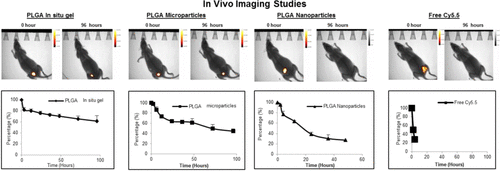当前位置:
X-MOL 学术
›
Mol. Pharmaceutics
›
论文详情
Our official English website, www.x-mol.net, welcomes your
feedback! (Note: you will need to create a separate account there.)
Intraductal Drug Delivery to the Breast: Effect of Particle Size and Formulation on Breast Duct and Lymph Node Retention.
Molecular Pharmaceutics ( IF 4.5 ) Pub Date : 2020-01-10 , DOI: 10.1021/acs.molpharmaceut.9b00879 Mibin Kuruvilla Joseph 1 , MdSaiful Islam 1 , Joshua Reineke 1 , Michael Hildreth 2 , Tofuko Woyengo 3 , Angela Pillatzki 4 , Aravind Baride 5 , Omathanu Perumal 1
Molecular Pharmaceutics ( IF 4.5 ) Pub Date : 2020-01-10 , DOI: 10.1021/acs.molpharmaceut.9b00879 Mibin Kuruvilla Joseph 1 , MdSaiful Islam 1 , Joshua Reineke 1 , Michael Hildreth 2 , Tofuko Woyengo 3 , Angela Pillatzki 4 , Aravind Baride 5 , Omathanu Perumal 1
Affiliation

|
Drug delivery by direct intraductal administration can achieve high local drug concentration in the breast and minimize systemic levels. However, the clinical application of this approach for breast cancer treatment is limited by the rapid clearance of the drug from the ducts. With the goal of developing strategies to prolong drug retention in the breast, this study was focused on understanding the influence of particle size and formulation on breast duct and lymph node retention. Fluorescent-labeled polystyrene (PS) particles ranging in size from 100 to 1000 nm were used to study the influence of particle size. Polylactic acid-co-glycolic acid (PLGA) was used to develop and test formulations for intraductal delivery. Cy 5.5, a near-IR dye, was encapsulated in PLGA microparticles, nanoparticles, and the in situ gel to study the biodistribution in rats using an in vivo imager. PS microparticles (1 μm) showed longer retention in the duct compared to 100 and 500 nm nanoparticles. The ductal retention half-life was 5-fold higher for PS microparticles compared to the nanoparticles. On the other hand, the free dye was cleared from the breast within 6 h. PLGA nanoparticles sustained the release of Cy 5.5 for >4 days. Microparticles and gel showed a much slower release than nanoparticles. PLGA in situ gel and microparticles were retained in the breast for up to 4 days, while the nanoparticles were retained in the breast for 2 days. PLGA nanoparticles and microparticles drained to the axillary lymph node and were retained for up to 24 and 48 h, respectively, while the in situ gel and the free dye did not show any detectable fluorescence in the lymph nodes. Taken together, the results demonstrate the feasibility of prolonged retention in the breast duct and lymph node by optimal formulation design. The findings can serve as a framework to design formulations for localized treatment of breast cancer.
中文翻译:

乳内导管内给药:粒径和配方对乳腺导管和淋巴结保留的影响。
通过直接导管内给药的药物递送可以在乳房中达到较高的局部药物浓度,并使全身水平降至最低。但是,这种方法在乳腺癌治疗中的临床应用受到药物从导管快速清除的限制。为了制定延长乳腺药物保留时间的策略,本研究着重于了解粒径和制剂对乳腺导管和淋巴结保留的影响。荧光标记的聚苯乙烯(PS)颗粒的大小在100到1000 nm之间,用于研究粒径的影响。聚乳酸-共乙醇酸(PLGA)用于开发和测试用于导管内递送的制剂。Cy 5.5(一种近红外染料)被封装在PLGA微粒,纳米颗粒,以及原位凝胶,以使用体内成像仪研究大鼠体内的生物分布。与100和500 nm纳米颗粒相比,PS微粒(1μm)在导管中的保留时间更长。与纳米颗粒相比,PS微粒的导管保留半衰期高出5倍。另一方面,游离染料在6小时内从乳房中清除。PLGA纳米颗粒持续释放Cy 5.5超过4天。微粒和凝胶的释放比纳米颗粒慢得多。PLGA原位凝胶和微粒在乳房中保留长达4天,而纳米粒子在乳房中保留2天。PLGA纳米颗粒和微粒排放到腋窝淋巴结并分别保留长达24小时和48小时,而原位凝胶和游离染料在淋巴结中未显示任何可检测的荧光。两者合计,结果证明了通过最佳配方设计延长保留在乳腺导管和淋巴结中的可行性。该发现可以作为设计用于乳腺癌局部治疗的制剂的框架。
更新日期:2020-01-10
中文翻译:

乳内导管内给药:粒径和配方对乳腺导管和淋巴结保留的影响。
通过直接导管内给药的药物递送可以在乳房中达到较高的局部药物浓度,并使全身水平降至最低。但是,这种方法在乳腺癌治疗中的临床应用受到药物从导管快速清除的限制。为了制定延长乳腺药物保留时间的策略,本研究着重于了解粒径和制剂对乳腺导管和淋巴结保留的影响。荧光标记的聚苯乙烯(PS)颗粒的大小在100到1000 nm之间,用于研究粒径的影响。聚乳酸-共乙醇酸(PLGA)用于开发和测试用于导管内递送的制剂。Cy 5.5(一种近红外染料)被封装在PLGA微粒,纳米颗粒,以及原位凝胶,以使用体内成像仪研究大鼠体内的生物分布。与100和500 nm纳米颗粒相比,PS微粒(1μm)在导管中的保留时间更长。与纳米颗粒相比,PS微粒的导管保留半衰期高出5倍。另一方面,游离染料在6小时内从乳房中清除。PLGA纳米颗粒持续释放Cy 5.5超过4天。微粒和凝胶的释放比纳米颗粒慢得多。PLGA原位凝胶和微粒在乳房中保留长达4天,而纳米粒子在乳房中保留2天。PLGA纳米颗粒和微粒排放到腋窝淋巴结并分别保留长达24小时和48小时,而原位凝胶和游离染料在淋巴结中未显示任何可检测的荧光。两者合计,结果证明了通过最佳配方设计延长保留在乳腺导管和淋巴结中的可行性。该发现可以作为设计用于乳腺癌局部治疗的制剂的框架。











































 京公网安备 11010802027423号
京公网安备 11010802027423号